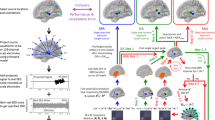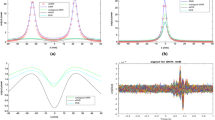Abstract
Simultaneous magnetoencephalography (MEG) and electroencephalography (EEG) analysis is known generally to yield better localization performance than a single modality only. For simultaneous analysis, MEG and EEG data should be combined to maximize synergistic effects. Recently, beamformer for simultaneous MEG/EEG analysis was proposed to localize both radial and tangential components well, while single modality analyses could not detect them, or had relatively higher location bias. In practice, most interesting brain sources are likely to be activated coherently; however, conventional beamformer may not work properly for such coherent sources. To overcome this difficulty, a linearly constrained minimum variance (LCMV) beamformer may be used with a source suppression strategy. In this work, simultaneous MEG/EEG LCMV beamformer using source suppression was formulated firstly to investigate its capability over various suppression strategies. The localization performance of our proposed approach was examined mainly for coherent sources and compared thoroughly with the conventional simultaneous and single modality approaches, over various suppression strategies. For this purpose, we used numerous simulated data, as well as empirical auditory stimulation data. In addition, some strategic issues of simultaneous MEG/EEG analysis were discussed. Overall, we found that our simultaneous MEG/EEG LCMV beamformer using a source suppression strategy is greatly beneficial in localizing coherent sources.






Similar content being viewed by others
References
Babiloni F, Carducci F, Cincotti F, Gratta CD, Pizzella V, Romani GL, Rossini PM, Tecchio F, Babiloni C (2001) Linear inverse source estimate of combined EEG and MEG data related to voluntary movements. Hum Brain Mapp 14(4):197–209
Baillet S, Garnero L, Marin G, Hugonin JP (1999) Combined MEG and EEG source imaging by minimization of mutual information. IEEE Trans Biomed Eng 46(5):522–534
Baillet S, Mosher JC, Leahy RM (2001) Electromagnetic brain mapping. IEEE Signal Process Mag 18(6):14–30
Brookes MJ, Stevenson CM, Barnes GR, Hillebrandb A, Simpsonb MIG, Francisa ST, Morrisa PG (2007) Beamformer reconstruction of correlated sources using a modified source model. NeuroImage 34(4):1454–1465
Cohen D (1968) Magnetoencephalography: evidence of magnetic fields produced by alpha-rhythm currents. Science 161(3843):784–786
Cohen D, Cuffin BN (1979) Comparison of the magnetoencephalogram and electroencephalogram. Electroenceph Clin Neurophysiol 47:132–146
Cohen D, Cuffin BN (1983) Demonstration of useful differences between magnetoencephalogram and electroencephalogram. Electroenceph Clin Neurophysiol 56:38–51
Cohen D, Cuffin BN (1991) EEG versus MEG localization accuracy: theory and experiment. Brain Topogr 4(2):95–103
Dalal SS, Sekihara K, Nagarajan SS (2006) Modified beamformers for coherent source region suppression. IEEE Trans Biomed Eng 53(7):1357–1363
Dalal SS, Baillet S, Adam C, Ducorps A, Schwartz D, Jerbi K, Bertrand O, Garnero L, Martinerie J, Lachaux JP (2009) Simultaneous MEG and intracranial EEG recordings during attentive reading. NeuroImage 45:1289–1304
Darvas F, Pantazis D, Kucukaltun-Yildirim E, Leahy RM (2004) Mapping human brain function with MEG and EEG: methods and validation. NeuroImage 23(Suppl 1):S289–S299
Gross J, Ioannides AA (1999) Linear transformations of data space in MEG. Phys Med Biol 44:2081–2097
Gross J, Kujala J, Hämäläinen M, Timmermann L, Schnitzler A, Salmelin R (2001) Dynamic imaging of coherent sources: studying neural interactions in the human brain. PNAS 98(2):694–699
Hämäläinen M, Sarvas J (1989) Realistic conductivity geometry model of the human head for interpretation of neuromagnetic data. IEEE Trans Biomed Eng 36(2):165–171
Hämäläinen M, Hari R, Ilmoniemi RJ, Knuutila J, Lounasmaa OV (1993) Magnetoencephalography–theory, instrumentation, and applications to noninvasive studies of the working human brain. Rev Mod Phys 65(2):413–497
Hansen PC (1998) Rank-deficient and discrete Ill-posed problems: numerical aspects of linear inversion. SIAM monographs on mathematical modeling and computation. Society for Industrial and Applied Mathematics, Philadelphia
Henson RN, Mouchlianitis E, Friston KJ (2009) MEG and EEG data fusion: simultaneous localisation of face-evoked responses. NeuroImage 47:581–589
Hong JH, Jun SC “Scanning reduction strategy in MEG/EEG beamformer source imaging,” J Appl Math, 2012, Article ID 528469. doi:10.1155/2012/528469
Huizenga HM, van Zuijen TL, Heslenfeld DJ, Molenaar PCM (2001) Simultaneous MEG and EEG source analysis. Phys Med Biol 46:1737–1751
Jun SC (2010) MEG and EEG fusion in Bayesian frame. In: Proceeding of ICEIE, vol 2, pp 295–299
Jun SC, George JS, Paré-Blagoev J, Plis SM, Ranken DM, Schmidt DM, Wood CC (2005) Spatiotemporal Bayesian inference dipole analysis for MEG neuroimaging data. NeuroImage 28(1):84–98
Jun SC, George JS, Kim W, Paré-Blagoev J, Plis SM, Ranken DM, Schmidt DM (2008) Bayesian brain source imaging based on combined MEG/EEG and fMRI using MCMC. NeuroImage 40(4):1581–1594
Kim K (2011) “Source-space waveform reconstruction for coherent brain signals,” Proc. APSIPA Conf
Ko S, Jun SC (2010) “Beamformer for simultaneous magnetoencephalography and electroencephalography analysis,” J Appl Phys 107:09B315
Liu H, Tanaka N, Stufflebeam S, Ahlfors S, Hamalainen M (2010) “Functional Mapping with Simultaneous MEG and EEG,” J Vis Exp. doi: 10.3791/1668
Mauguiere F (1992) A consensus statement on relative merits of EEG and MEG. Electroenceph Clin Neurophysiol 82(5):317–319
Moiseev A, Gaspar JM, Schneider JA, Herdman AT (2011) Application of multi-source minimum variance beamformers for reconstruction of correlated neural activity. NeuroImage 58:481–496
Phillips JW, Leahy R, Mosher JC, Timsari B (1997) Imaging neural activity using MEG and EEG. IEEE Eng Med Biol Mag 16(3):34–42
Sarvas J (1987) Basic mathematical and electromagnetic concepts of the biomagnetic inverse problem. Phys Med Biol 32:11–22
Sekihara K, Nagarajan SS (2008) Adaptive spatial filters for electromagnetic brain imaging. Springer, Berlin
Sekihara K, Nagarajan SS, Poeppel D, Marantz A, Miyashita Y (2001) Reconstructing spatio-temporal activities of neural sources using an MEG vector beamformer technique. IEEE Trans Biomed Eng 48(7):760–771
Sekihara K, Nagarajan SS, Poeppel D, Marantz A (2002) Performance of an MEG adaptive-beamformer technique in the presense of correlated neural activities: effect on signal intensity and time-course estimates. IEEE Trans Biomed Eng 49(12):1534–1546
Sekihara K, Nagarajan SS, Poeppel D, Marantz A, Miyashita Y (2002) Application of an MEG eigenspace beamformer to reconstructing spatio-temporal activities of neural sources. Hum Brain Mapp 15(4):199–215
Sekihara K, Sahani M, Nagarajan SS (2005) Localization bias and spatial resolution of adaptive and non-adaptive spatial filters for MEG source reconstruction. NeuroImage 25:1056–1067
Shimogawara M, Tanaka H, Kazumi K, Haruta Y (2004) “MEGvision Magnetoencephalograph system and its applications. Yokogawa Tech Rep 38:23–27
van Veen BD, Buckley KM (1988) Beamforming: a versatile approach to spatial filtering. IEEE Acoust Speech Signal Proc Mag 5:4–24
Van Veen BD, van Drongelen W, Yuchtman M, Suzuki A (1997) Localization of brain electrical activity via linearly constrained minimum variance spatial filtering. IEEE Trans Biomed Eng 44(9):867–880
Yoshinaga H, Nakahori T, Ohtsuka Y, Oka E, Kitamura Y, Kiriyama H, Kinugasa K, Miyamoto K, Hoshida T (2002) Benefit of simultaneous recording of EEG and MEG in Dipole Localization. Epilepsia 43:924–928
Zhang Z (1995) A fast method to comput surface potentials generated by dipoles within multilayer anisotropic spheres. Phys Med Biol 40:335–349
Acknowledgments
This work was supported by the Korea Research Council of Fundamental Science and Technology (KRCF) through the Basic Research Project managed by KRISS. We would like to thank Dr. Haruta at Yokogawa Electric Corp. for assistance in the MEG and EEG data acquisition.
Author information
Authors and Affiliations
Corresponding author
Rights and permissions
About this article
Cite this article
Hong, J.H., Ahn, M., Kim, K. et al. Localization of coherent sources by simultaneous MEG and EEG beamformer. Med Biol Eng Comput 51, 1121–1135 (2013). https://doi.org/10.1007/s11517-013-1092-z
Received:
Accepted:
Published:
Issue Date:
DOI: https://doi.org/10.1007/s11517-013-1092-z




